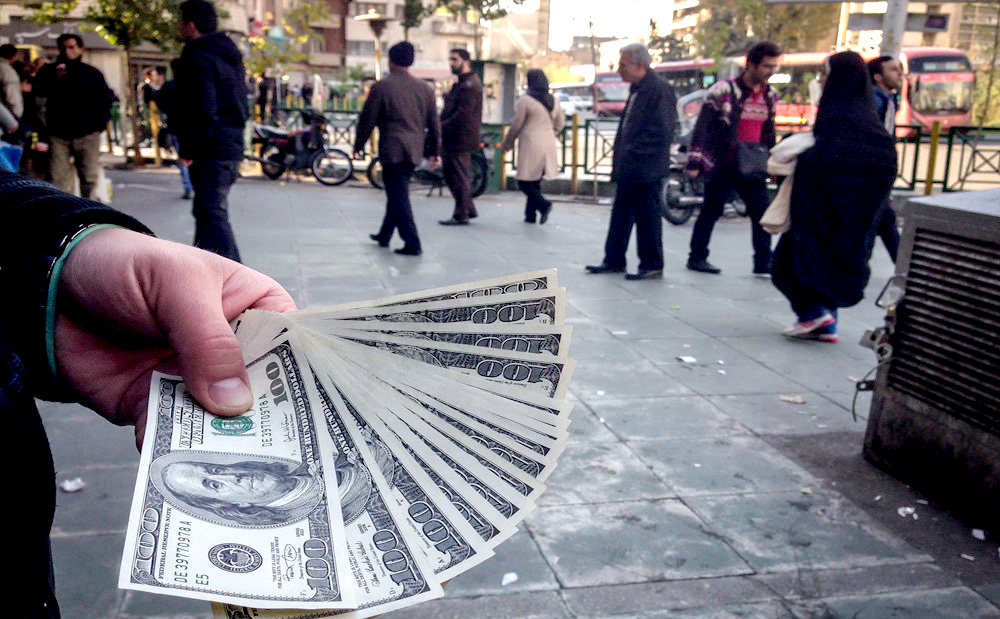The US dollar is in the midst of an intensive bull run, with the currency again crossing the psychological threshold of 35,000 rials. On Saturday, however, the currency entered new territory to be sold at a record 36,000 rials—a rate last recorded in December 2014 when Tehran was negotiating a highly sensitive nuclear deal with the six world powers.
As of 1100 a:m GMT Sunday, the greenback lost some ground and bought 35,880 rials. Market observers believe that the rally for the currency is all but over.
From falling oil prices that have severely hurt foreign exchange revenues to public expectations of economic upliftment following the prospect of sanctions relie, rise in demand for hard currency for travel and the recent auto loan scheme of the government, a host of other reasons are mentioned for the sharp decline in the value of the rial.
"The recent oil price drop and diminishing foreign exchange reserves have prompted some to hoard dollars, sending the greenback higher," said Abolfazl Golpayegani, Industries Committee chairman at Tehran Chamber of Commerce, Industries, Mines and Agriculture.
He says that since automakers will need more foreign exchange to import raw material and parts in the coming months, the dollar rate could rise further. The recent auto loan which saw over 130,000 cars sold within less than a week has given carmakers added motivation to step up production.
While the free market rate has experienced significant volatility, the subsidized (official) rate of the dollar has remained out of the storm's eye by hovering at 29,960 rials.
This has once again strengthened the rumors about a government agenda to let the rial depreciate against other currencies to partly plug holes in its budget -- a measure not uncommon for governments in desperate times.
"Foreign exchange is a commodity over which the government has total monopoly and whenever the state budget hits a bump or the government needs cash, a ready solution is to reduce the value of the rial," said Heidar Mostakhdemin Hosseini, a prominent analyst.
Payman Arghavani, a bureau de change operator in central Tehran has similar views. Although he believes any prognosis of the forex market is next to impossible, but expects rates to remain high until the government finds the money to pay the monthly cash subsidy on Tuesday.
"The government usually sells dollars when the rates are high to boost its income, but after the cash subsidies are paid on Tuesday we expect the market to cool down since the terror attacks in Paris have lowered global demand for foreign exchange," Arghavani told the Financial Tribune.
He said the high inflation rates are also at play, in which the government's monetary easing programs have also had a role.
Samad Karimi, head of the Export Office at the Central Bank of Iran, however, tried to dispel allegations of government intervention in the forex rates by claiming a few days ago that the CBI had kept the official rates stable "by utilizing complex economic variables."
Market Villainy
Apart from what has contributed to the rial's misfortune this time around, market observers point to the ill effects of a weaker national currency on the economy. Experience has it that whenever the national currency takes a beating, consumer prices rise dramatically.
Noting that the government and CBI have plans to let the rial depreciate further, Vahid Shaghaghi, a Tehran-based economist says this would ultimately give little respite to government coffers and not impact the export-import market in a tangible way.
"When the greenback rises, it increases the cost of imports which in turn stokes inflation because Iranians are large consumers of foreign products," he told a local newspaper on Sunday.
The analyst warns that rail devaluation might be a winning game for the government but the people are the ultimate losers. And while a dual exchange rate regime is still a stumbling block in the way of genuine economic reform and transparency, the government has yet to take concrete steps to make good on its promises of unifying the exchange rates.



